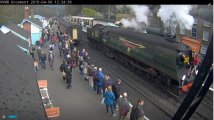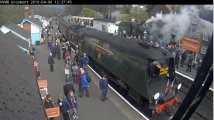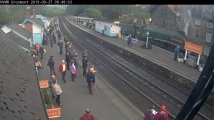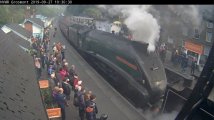So Rod why do you think these preservation railway companies take on too much rolling stock that they never seem to run [based on what you said about the stuff under wraps at Pickering being there for years] are they future Projects for restoration that they believe they can save and use sometime in the future . Given even at the height of summer the frequency of trains running is not concentrated surely they only need a finite number of coaches .
There is probably more rolling sock than there is sings overall as some are:
a) pet projects but there is no cash at present to take forward, buying the carcass or heap of parts is relatively cheap compared to the cash, time and expertise to "restore" it to use which will be historically accurate and safe in modern terms for use. Some I believe pay for the storage so it is a form of income which is vital for any heritage set up.
b) donated items from industrial sites which it would seem churlish to refuse but are of only marginal utility: I am thinking here some non passenger stock which has a use for demonstration freight or engineering trains but is not a great revenue earner yet often need substantial input before they can be used safely. I suspect some will hardly move at all. Often you will see a lengthy line of freight stock, quite rusty and battered met of which will have been donated. But occasionally you will see a restored wagon and they do look very effective. Brake vans are also useful for certain types of trips especially the Queen Mary style (25T SR examples) as they hold a lot of people.
c) some are very elderly stock which is genuinely historical but may need extensive work to make them compliant with modern standards for public use and sourcing of parts may be difficult as well as expensive. The time scale for such renovations is in years if not decades.
d) spare parts. Many carriages now in use are from the 1950s and the bogies will need extensive work and sometimes the stock is wanted for exactly just that - the bogies or a more modern under frame for a much older body but the restoration plans may stretch years ahead. They need storing somewhere where they can be eventual;l;y towed out to be used so take up siding space. Also old stock may have better seat squabs, doors and panelling which will be needed in the future.
You say a finite number of coaches - this is true but they wear out. The interior panelling requires extensive work.Many heritage lines, especially if they run east - west. find one side of the stock fades badly in the sun so needs frequent repainting , maroon being a particularly fugitive hue. As an aide to this on the Southern they revarnished rather than repainted and early BR finish in crimson before they allowed them to continue in green eventually became pink by 1960! The running gear will end replacing.
Also some lines do have a very long term plan to extend: the Bluebell has done so, the Wensleydale wants to but these are very long term, I once was talking to somebody on the Wensleydale railway and she said that it would not be in hers or my life times when they reached backed to Garsdale which is the ultimate aim. Once longer they will need more stock and possibly have more space to store some in a siding or two.
Also there is need to encompass disability access provision which standard coaches are not good at and some alterations are required to accommodate this without just placing wheelchair users in the former luggage compartment. It means widening entrances to the coach and the saloon although I would say there are plenty of TSO carriages so changing some would not be a loss in heritage.
One of the other problems is there area lot of small diesel shunters available and preserved but they are usually not able to be used because of power requirements or braking arrangements or lack of steam heating. Need to be stored somewhere.
There probably is no more spare stock available. But is not just heritage lines - West Coast Railways at the former Steam Town in Carnforth have several sidings full of rough mk II coaches, spares or repair. Also they have a lot of old parcels vans wanted purely for the commonwealth bogies as these are rated at 100 mph.
An ideal heritage railway would have a hidden yard where all this clutter could be stored out of sight but generally there is no such space available in the track bed area or if there is it is difficult to screen. In the 1950s most yards always had few wagons on show, some probably having been in position near the buffers for years, but with plenty of empty siding space. These lines never had carriage sheds or locomotive building works as these were always at central location such as Brighton, Eastleigh or Ashford (you might notice I am really SR although have lived in Yorkshire for over half my life) but now have to as many are not even connected to the main line. A lot of the former goods yards get structures built to hold stock but usually that is a place to work on them out of the cold and wet.



 The camera there is now pointed at the roof of one of the buildings and seems to be swaying in the wind !
The camera there is now pointed at the roof of one of the buildings and seems to be swaying in the wind ! . Lets hope he comes clean and admits it so they can wipe the slate clean
. Lets hope he comes clean and admits it so they can wipe the slate clean 
 Its called "CITY OF WELLS "
Its called "CITY OF WELLS "





